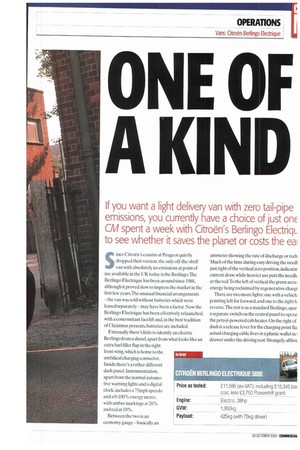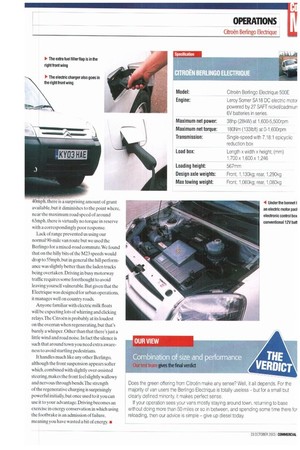E OF
Page 47

Page 48

Page 49

If you've noticed an error in this article please click here to report it so we can fix it.
A I( FAI 1:1
If you want a light delivery van with zero tail-pipe emissions, you currently have a choice of just onE CM spent a week with Citroen's Berlingo ElectriqL to see whether it saves the planet or costs the ea!
Since Citroen's cousins at Peugeot quietly dropped their version, the only off-the-shelf van with absolutely no emissions at point of use available in the UK today is the Berlingo.The Berlingo Electrique has been around since 1988, although it proved slow to impress the market in the first few years.The unusual financial arrangements — the van was sold without batteries which were leased separately — may have been a factor. Now the Berlingo Electrique has been effectively relaunched. with a concomitant facelift and, in the best tradition of Christmas presents,batteries are included.
Externally there's little to identify an electric Berlingo from a diesel, apart from what looks like an extra fuel filler flap in the right front wing, which is home to the umbilical charging connector. Inside there's a rather different dash panel. Instrumentation. apart from the normal automotive warning lights and a digital clock.includes a 75mph speedo and a 0-100% energy meter, with amber markings at 20% and red at 10%.
Between the two is an economy gauge — basically an ammeter showing the rate of discharge or rech Much of the time during easy driving the need] just right of the vertical zero position,indicatin current draw, while heavier use puts the needle er the red.To the left of vertical the green area energy being reclaimed by regenerative chargi There are two more lights: one with a vehicle pointing left for forward, and one to the right fc reverse.The rest is as a standard Berlingo,apar a separate switch on the central panel to operal the petrol-powered cab heater. On the right of dash is a release lever for the charging point flai actual charging cable lives in a plastic wallet ini drawer under the driving seat.Strangely,althot the van came with the facelifted exterior and chequerplate-pattern seats, the fascia was from the previous Berlingo.
Although a full range of bulkheads is available, ours came with the basic half-width ladder-frame option, but this was paired with a unique thermal curtain to maintain cockpit heat and improve the effectiveness of the independent heater.
Under the bonnet the dominant feature is the electric motor pack, behind which is the electronic control box, topped with filler tubes for the batteries.A conventional 12V battery provides normal automotive functions and is charged separately.
There's an electric power steering pump and reservoir and screenwash bottle, and that's it.
The 360kg battery pack lives under the load floor, out of sight and mind. Charging the batteries simply involves plugging one end of the cable into the wing socket and the other into a normal domestic three-pin socket.A full charge takes up to nine hours, but a fast charge facility is reckoned to add 2km of range per minute. We weren't brave enough to try a full 50-mile commute on a single charge, instead plugging it in at the office for a daytime top-up.
PRODUCTIVITY The benefits of the Berlingo Electrique are two-fold. Firstly. the environmental factor, in the form of those zero tail-pipe emissions, although of course the electricity to power the van has to be produced somewhere.The second factor, economics, is slightly harder to evaluate:The initial purchase price of £15,345, which now includes the cost of the batteries, is around 50% higher than a diesel equivalent. But at the expense of jumping through a few bureaucratic hoops, the government-backed Powershift initiative will refund £3,750 to qualifying operators.
A full charge of the batteries costs less than £1,considerably less if using an off-peak tariff. Being conservative and counting on a 50-mile range, this works out at a direct fuel cost of I -2p/mile, while a similar sized diesel-powered van would be costing around 7p/mile.Added to this, though.is the cost of the battery pack. This should last somewhere between five and seven years, with replacements costing something approaching £5,000. However, in practice, we would expect any whole-life cost calculations to have written the van down to virtually zero over this time span, so the battery replacement cost could be said to he hypothetical.
There are other financial benefits available, starting with zero road tax. Others depend on where you operate. London's congestion charging zone is free to electric vehicles, and some local authorities provide free parking. Indeed, CM's own local council , Sutton. offers free charging points in a town centre car park and free on-street parking.
In every other respect the Electrique version is the same as other Berlingos.As this power system was envisaged at the design stage the loadspace dimensions are unaffected by the battery pack, although the gross payload is reduced to 500kg.The only real negative effect is that the spare wheel is gone. to be replaced by an aerosol puncture repair outfit.Twin rear doors and a nearside sliding door are fitted as standard.
ON THE ROAD 'File Be dingo's driving controls are much the same as those in a conventional van —steering wheel, throttle, brake,just no clutch. Gears are selected by a simple automatic-type quadrant with PRND positions.To start just turn the key to the normal "on" position then one position further and wait for the sound of a clicking relay —that's it, the "engine's runnine,confirmed by the energy gauge coming to life.
Moving off is simply a case of engaging D and pressing the pedal. Because the motor develops maximum torque at minimum rpm. and vice versa, initial acceleration is very strong.Around town, up to 30 or 40mph. there is a surprising amount of grunt available, but it diminishes to the point where. near the maximum road speed of around 63mph, there is virtually no torque in reserve with a correspondingly poor response.
Lack of range prevented us using our normal 90-mile van route but we used the Berlingo for a mixed-road commute. We found that on the hilly bits of the M23 speeds would drop to 55mph. but in general the hill performance was slightly better than the laden trucks being overtaken. Driving in busy motorway traffic requires some forethought to avoid leaving yourself vulnerable. But given that the Electrique was designed for urban operations. it manages well on country roads.
Anyone familiar with electric milk floats will be expecting lots of whirring and clicking relays. The Citroen is probably at its loudest on the overrun when regenerating. but that's barely a whisper. Other than that the just a little wind and road noise. In fact the silence is such that around town you need extra awareness to avoid startling pedestrians.
It handles much like any other Berlingo. although the front suspension appears softer which.combined with slightly over-assisted steering, makes the front feel slightly wallowy and nervous through bends.The strength of the regenerative charging is surprisingly powerful initially, but once used to it you can use it to your advantage. Driving becomes an exercise in energy conservation in which using the footbrake is an admission of failure. meaning you have wasted a bit of energy.
































































































































































































